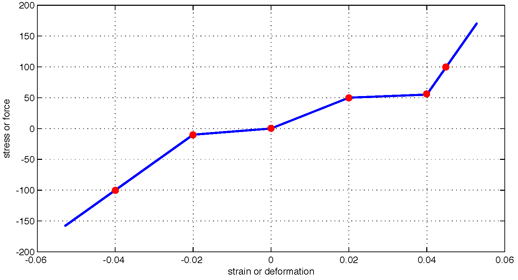ElasticMultiLinear Material: Difference between revisions
No edit summary |
No edit summary |
||
| Line 25: | Line 25: | ||
[[File:ElasticMultiLinear.png]] | [[File:ElasticMultiLinear.png]] | ||
---- | |||
EXAMPLE: | EXAMPLE: | ||
Revision as of 22:04, 2 September 2012
- Command_Manual
- Tcl Commands
- Modeling_Commands
- model
- uniaxialMaterial
- ndMaterial
- frictionModel
- section
- geometricTransf
- element
- node
- sp commands
- mp commands
- timeSeries
- pattern
- mass
- block commands
- region
- rayleigh
- Analysis Commands
- Output Commands
- Misc Commands
- DataBase Commands
This command is used to construct a multi-linear elastic uniaxial material object. The nonlinear stress-strain relationship is given by a multi-linear curve that is define by a set of points. The behavior is nonlinear but it is elastic. This means that the material loads and unloads along the same curve, and no energy is dissipated. The slope given by the last two specified points on the positive strain axis is extrapolated to infinite positive strain. Similarly, the slope given by the last two specified points on the negative strain axis is extrapolated to infinite negative strain. The number of provided strain points needs to be equal to the number of provided stress points.
| uniaxialMaterial ElasticMultiLinear $matTag -strain $strainPoints -stress $stressPoints |
| $matTag | integer tag identifying material |
| $strainPoints | array of strain points along stress-strain curve |
| $stressPoints | array of stress points along stress-strain curve |
EXAMPLE:
uniaxialMaterial ElasticMultiLinear 1 -strain -0.045 -0.04 -0.02 0.0 0.02 0.04 0.045 -stress 10 -100 -10 0 50 55 100
Code Developed by: Andreas Schellenberg, University of California, Berkeley.
